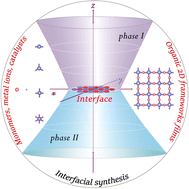Controlled growth of organic 2D layered material thin films via interfacial methods
Abstract
The isolation of graphene from graphite triggered enormous interest in the study of 2D materials due to their remarkable physical properties. These 2D materials feature many unique properties, such as atomically thin flakes, a layered structure, a long-range order and a dangling bond-free surface, which are promising for broad applications in various fields including (opto)electronics, spintronics, catalysis and so on. Specially, organic 2D layered materials have the prominent advantage of their designable and tailorable chemical structure at the atomic level. The preparation of organic 2D layered material thin films has become a very hot research topic in the materials fields because of their great potential to be integrated into advanced nanodevices. Considering the lack of large single crystal samples, it is not possible to obtain large-scale films from the traditional top-down exfoliation methods. Various groups and our previous studies prove the efficiency of interfacial synthesis methods for high-quality organic 2D layered material thin film preparation by restricting the reaction at the two-phase boundary area within a plane. As the performance of resultant films is highly related to their “quality” in aspects of continuity, crystallinity, uniformity, and thickness, the selection of interfaces and conditions is vitally important. Until now, many interfacial synthesis methods have been developed and modified for the controlled growth of high-quality organic 2D layered material thin films. This feature article reviews the recent advances in organic 2D layered material thin film preparation by interfacial methods. First, how the features of the interface affect the growth behavior of organic 2D layered materials is analyzed. Then, varieties of organic 2D layered material thin films with different chemical structures grown at various interfaces are discussed. Finally, the challenges and prospects in the interfacial synthesis of high-quality organic 2D layered materials are also explored.



 Please wait while we load your content...
Please wait while we load your content...